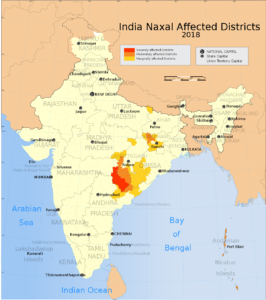Introduction:
For many years, Left Wing Extremism (LWE), also known as Naxalism, has been a significant security threat in India. The Naxalbari village in West Bengal, where the violent struggle for land rights and the overthrow of the current social and political order started in 1967, is where the term “Naxalism” originated. Since then, Naxalism has established roots in other states, posing a serious danger to the nation’s internal security, economic growth, and democratic structure. This blog post will examine Naxalism’s sources, effects, and measures to counter them in India, with a particular focus on the years following 2000.

IND vs AUS Live Score, WTC Final 2023: India 151/5 at Stumps on Day 2, still trail by 318 runs
Historical Context and Ideological Basis:
Understanding the historical setting and ideological underpinnings of Naxalism is crucial to comprehending its emergence. The ideology of Mao Zedong’s revolution in China served as the inspiration for the movement, which began as a branch of the Communist Party of India (Marxist). The Naxalites supported protracted people’s wars, class conflict, and military conflict as means of establishing a communist state. Their main complaints related to agrarian problems, land redistribution, landlord and capitalist exploitation, and the disregard for tribal populations.
Geographical Spread and Impact
The states of Chhattisgarh, Jharkhand, Odisha, Bihar, Andhra Pradesh, Maharashtra, and Telangana are the most affected by naxalism. These regions are characterised by poverty, poor governance, a lack of development, and concentrations of tribal populations, which are favourable conditions for the emergence of naxalism. The effects of Naxal violence have been profound, hurting not just economic growth, infrastructure development, and the rule of law, but also the lives of citizens. Thousands of people have died as a result of attacks on security personnel, public servants, and common citizens, instilling fear and instability.
Socio-Economic Factors Fuelling Naxalism
Naxalism continues to exist due to a number of socioeconomic issues. The movement’s expansion is fueled by the pervasive problems of poverty, unemployment, homelessness, and socioeconomic inequities. In marginalised communities, tribal estrangement, exploitation, and the denial of fundamental rights all contribute to resentment and a sense of unfairness. The cycle of poverty and disempowerment is further perpetuated by lack of access to key services like education and healthcare, which leaves vulnerable groups in society more open to Naxalite beliefs.
Weak Governance and Corruption:
Naxalism has persisted due in large part to lax governance frameworks and widespread corruption in the impacted areas. Naxalite organisations have been able to take advantage of the governance gap due to a lack of development efforts, limited law enforcement, and insufficient administrative capability. Corruption, both at the local and higher levels, exacerbates complaints and undermines trust in the government apparatus, giving the Naxalites a favourable environment in which to spread their ideas and find new followers.
Security Forces and Counterinsurgency Efforts:
To combat Naxalism, the Indian government has used a multifaceted approach. Launched in 2009, Operation Green Hunt sought to increase anti-Naxal operations by deploying a sizable number of security forces. The administration has also placed a priority on enhancing information gathering, security agency collaboration, and state police force capacity building. By putting into practise plans aimed at rural development, land reforms, and enhancing the living conditions of marginalised populations, efforts have been made to strengthen the socio-economic framework.
Challenges and the Way Forward
Despite these initiatives, naxalism still poses a serious problem. The motion changes
Here are some additional points to add:
Adaptability and Guerrilla Tactics
In order to elude security forces, naxalite groups have shown a remarkable degree of adaptability by using guerilla tactics and strategic mobility. They frequently operate in isolated, heavily forested areas, giving them a tactical advantage. The capacity of these groups to take advantage of local grievances, maintain a support network, and enlist new recruits continues to be a problem for counterinsurgency operations.
Human Rights Concerns
Concerns about human rights breaches have been raised in relation to government counterinsurgency efforts. Human rights organisations are concerned about incidents of disproportionate use of force, extrajudicial executions, and arbitrary arrests. In order to solve the Naxalism issue and gain the trust of the afflicted people, it is essential to strike a balance between upholding law and order and safeguarding human rights.
Development and Governance Initiatives
The administration has launched a number of governance and development programmes, realising that resolving socioeconomic inequalities is essential to battling naxalism. These include of basic service supply, skill-development initiatives, rural employment plans, and infrastructural projects. But the implementation of these programmes has frequently been hampered by red tape, corruption, and poor monitoring systems, which has reduced their practical impact.
Rehabilitation and Reintegration
An effort has been made to rehabilitate and reintegrate Naxalite cadres who turn themselves in, in addition to the security strategy. In order to promote their reintegration into society, rehabilitation programmes work to give people chances for skill development, education, and financial support. The effectiveness of such programmes, however, hinges on a thorough and all-encompassing strategy that addresses the underlying socio-economic issues that lead people to Naxalism.
International Cooperation:
Naxalism is a problem that affects more than simply India. There have been reports of connections between Naxalite groups and other extreme organisations, giving it a transnational scope. To cut down on external support networks and stop the inflow of weaponry and resources, it is essential to strengthen international collaboration, particularly with neighbouring nations, in intelligence sharing, border security, and fighting financing of terrorism.
Conclusion:
India’s socioeconomic progress and national security continue to be constantly threatened by naxalism. It is imperative to address the main causes of naxalism, which include socioeconomic inequalities, poor governance, and insufficient access to fundamental services. It is vital to have a comprehensive approach that includes governance initiatives, human rights protection, development initiatives, and security measures. The national and state governments, intelligence services, security forces, civil society groups, and local communities should work closely together to implement this strategy. India can work towards long-term peace, stability, and inclusive development in the impacted areas by tackling the multidimensional character of Naxalism.































